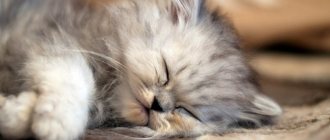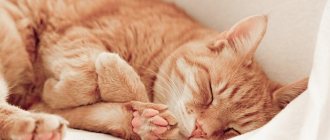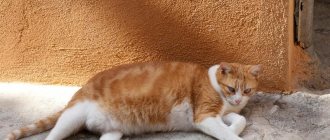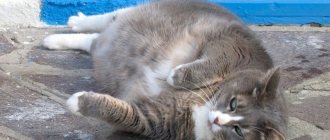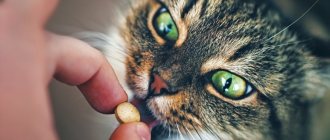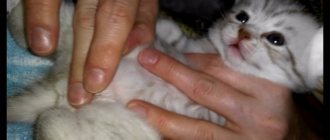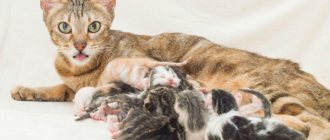There is a misconception that all cats easily bear kittens and give birth without outside help. However, purebred pets often require assistance both during gestation and at the birth stage.
Let's find out how a cat's pregnancy should proceed, what symptoms are a reason to see a doctor, and how a responsible owner should prepare for childbirth.
How long does pregnancy last in cats?
Pregnancy in cats can last from 63 to 67 days. These are average indicators, which are influenced by breed characteristics, number of kittens and other factors. Thus, long-haired breeds usually bear offspring for 10 weeks, and short-haired breeds - 9.
For each breed, the average duration of pregnancy is determined.
| Breed | Duration of gestation, days |
| British Shorthair | 63–69 |
| Scottish lop-eared | 62–69 |
| Bengal | 61–70 |
| Sphinx | 63–66 |
| Maine Coon | 66–68 |
| Oriental cat | 65–66 |
| Somali and Abyssinian | 63–65 |
| Persian | 63–66 |
| Siamese | 59–64 |
The average cat bears kittens for 65–70 days. These values are influenced by the quality of life, the animal’s nutrition, the presence of stress and physical health. Up to three pregnancies are possible per year, but such a frequency of births greatly depletes the body.
For this reason, yard cats cannot boast of their longevity. And it is customary to breed purebreds no more than 3 times every two years.
Important! If the animal does not have breeding value and there are no plans to produce offspring, it is better to carry out sterilization. The optimal age for the procedure is 7–8 months.
Maximum delay in labor
Cats carry kittens for about 2 months. If we take into account the average, a normal pregnancy lasts up to 72 days. If labor has not begun by this time, you should contact a veterinarian. Long term carrying of kittens is dangerous for both newborns and the cat.
Premature birth is no less risky. Kittens born on the 58th day of pregnancy or earlier are considered premature. They are weak and in most cases doomed to death.
Important! If a cat does not have a suitable birthing area, she may abort the contractions and pause labor.
Stages of lambing for a cat
Labor is divided into three stages:
- Contraction of the uterus and its gradual opening. The external symptom is discharge - the mucous plug that covers the entrance to the cervix comes out. Contractions appear and become more frequent.
- Increased frequency of contractions, complete opening of the cervix. The movement of the fetus along the birth canal into the second phase is accompanied by the mother cat’s attempts to push the baby out: the animal tenses. Kittens are born mainly in the amniotic sac. If the new mother did not help the child cleanse himself of it and did not lick it, then a person should help - carefully use scissors to make an incision on the bubble in the area of the muzzle, and the kitten itself is wiped with a cloth. Usually the female, on her own, carries out the procedure of breaking the bladder and licking its remains from the kitten’s body. The duration is 5-60 minutes.
The kitten did not come out an hour after the start of this stage? Urgent call to the vet!
- Once the baby is born, the placenta begins to come out, which the mother can eat after the kitten has been licked. It is better to remember how many placentas came out - there should be as many of them as kittens.
The kitten finds the nipple, labor resumes, and the next cub appears. The interval between two kittens can be from 10 to 60 minutes.
The whole process takes on average 6 hours.
Preparing cats for pregnancy
Planning pregnancy is the first and important step on the path to getting healthy offspring. First, anthelmintic treatment is carried out, and then comprehensive vaccination against viral diseases (panleukopenia, rhinotracheitis and calcivirus infection).
It is advisable for owners of a purebred animal to check their pet for genetic diseases to which a particular breed is prone. And to be completely sure that both animals are healthy, tests are carried out for coronavirus, immunodeficiency virus, herpes virus and other infections. Otherwise, infection can lead to a pathological course of pregnancy or cause physical abnormalities in kittens.
Nuances and possible complications
During pregnancy, cats can experience complications that can be caused by infections, genetic diseases, and even external factors. The life and health of your pet will depend on timely detection of the problem and contacting a doctor.
False pregnancy
If the mating was not successful, or the embryos did not attach to the uterus, a false pregnancy may occur. In this condition, the cat appears all the signs of pregnancy: reddening of the nipples, increased appetite and body weight, drowsiness and search for a secluded place. But at the appointed time there will be no labor activity, as well as fetal movement.
It is impossible to independently determine whether a cat is pregnant or a false pregnancy has occurred. This is the task of a veterinarian. Only an ultrasound of the abdominal cavity or its palpation can clarify the situation.
Most often, false pregnancy is provoked by the following factors:
- overweight cat;
- mating with a castrated or too young cat;
- hereditary predisposition (the Oriental breed, Cornish Rex and Sphynx are prone to it);
- close proximity to pregnant cats;
- severe stressful situations.
False pregnancy is dangerous if it is characterized by a long course or occurs several matings in a row. The condition leads to depletion of the body and can provoke mastitis, pyometra and other dangerous diseases.
Preventive measures will help prevent its occurrence:
- proper and balanced diet;
- calm atmosphere in the house;
- early diagnosis by a veterinarian;
- mating with a healthy, proven cat.
To stop this pathological process, the doctor may prescribe sedatives, as well as drugs to stop the production of cat milk.
Frozen pregnancy
Sometimes a cat may experience a frozen pregnancy. Stopping embryo development occurs for a number of reasons:
- unsuccessful previous pregnancies;
- hormonal imbalances;
- some infectious diseases;
- pathologies of uterine development.
Such changes lead to the death of one or more embryos. Consulting a veterinarian will allow you to assess the situation and prevent dangerous consequences. After all, if left in the womb for a long time, a frozen fetus can begin to rot, infect healthy fruits and harm the cat itself.
In this situation, the doctor will help you make the right decision: wait for a natural birth so that the embryo comes out with healthy kittens, or begin to immediately stimulate labor. If all the embryos freeze, a miscarriage occurs.
Important! Ultrasound examination will allow you to determine if a cat is pregnant or find out about the pathology of the fetus. This procedure also determines the kittens' heartbeat and their rate of development.
Superfetation
An unusual phenomenon in cats is parallel pregnancy or superfetation. This term implies the conception and gestation of two broods at different stages of maturation. The process is observed if the cat is bred again when she is already pregnant. In this case, embryos develop in the uterus with a significant difference in time. The gestational age usually does not increase.
Superfetation most often ends in the death of late fruits. When labor occurs, they are pushed out. It is much less common for cats to give birth twice when the remaining kittens are successfully carried to term. When diagnosing a parallel pregnancy, it is recommended that the birth be carried out under the supervision of a veterinarian. This can increase the chances of survival of the younger litter.
What are the dangers of early pregnancy in cats?
The first heat indicates the cat's readiness to become pregnant. This process is individual for each cat and can occur from 6 to 11 months. However, its appearance is not a reason to plan a mating.
Experts tend to believe that it is better to introduce a cat for the first time no earlier than a year. By this time, the animal’s body will be fully strengthened and will be able to bear healthy offspring. And in teenage cats, pathologies of fetal development are often observed.
Childbearing age
During puberty, physiological changes occur in the kitten's body, after which it becomes capable of reproducing. The period of onset of childbearing age depends on the following factors:
- breed
- diet
- individual characteristics
- conditions of detention
Short-haired breeds, such as Britons and Siamese cats, mature earlier. Puberty occurs at the age of 5-6 months.
In long-haired and large cats, the first heat comes at 10-12 months.
The optimal age for procreation is from one to one and a half years. Cats give birth without harm to their health starting from the second or third heat.
Interesting to know
Theoretically, a cat can become pregnant at any reproductive age because estrus occurs throughout her life. There is a known case where a cat from Great Britain gave birth to two kittens at the age of 30.
Features of the first pregnancy
During the first pregnancy, special care, feeding and maintenance of the cat are required. There are certain recommendations for this period:
- With natural nutrition, a complex of vitamin and mineral supplements is introduced into the diet.
- When feeding dry food, preference is given to the line for kittens or pregnant cats.
- By the 6th week of pregnancy, the frequency of feedings increases. In total, 4–5 appointments are carried out per day.
- Regularly weighing your pet will help prevent overfeeding. But it can lead to a difficult birth.
How many kittens can be born?
Number of kittens per lambing
How long do pregnant cats walk for the first time?
Cats are fertile. During a lifetime, all the offspring can amount to a hundred or even more. During one pregnancy, a mustachioed mother can carry and give birth to 5-7 kittens. There are cases that go beyond the average. The maximum recorded number of kittens is 15.
For your information! From a physiological point of view, the number of cubs born to a female rarely exceeds the number of nipples. The birth of one or two is considered a pathology for a cat, unless it is a primiparous female.
The number of kittens can be determined genetically, health status, and also depend on the breed of the cat. Street animals always bring more. In addition to difficult living conditions, this is explained by the low survival rate of offspring. Pets usually delight their owners with 5-6 kittens. Although Siamese breeds are highly fertile. The norm for them is 8-9 kittens.
Primiparous animals usually give birth to 1-3 kittens. The explanation for this is the incompletely formed reproductive system. In this way, nature protects the cat’s young, fragile body from excessive stress and stress. Older cats also give birth to few kittens, as the reproductive function fades.
Happy cat mom
The appearance of kittens in the house is a touching moment for the owners and their pet. The cat, as a rule, copes remarkably well at all stages of pregnancy. The owners' task is to help her. In this regard, it would be appropriate:
- preventive examination by a veterinarian before mating in order to exclude diseases of the animal;
- examination of the animal by a veterinarian during gestation to identify possible pathologies. Also, if any unfavorable symptoms appear (bloody discharge, systematic vomiting, prolonged refusal to eat, fever), immediately contact a specialist;
- careful handling of animals. It is necessary to exclude assault, pushing, and independent palpation of the abdomen;
- providing high-quality nutritious nutrition with the necessary supplements of vitamins and microelements;
- maintaining hygiene. It is necessary to carefully monitor the cleanliness of the tray, since in the second half of pregnancy the cat is forced to access it more often;
- equipment of a place for birth and postnatal stay of kittens;
- support during childbirth, so that if something happens, you can seek help from a veterinarian.
In any case, childbirth is a natural process for mustachioed mothers. As a rule, they cope with everything on their own, but sometimes the situation gets out of control and the help of a veterinarian is needed. You should not ignore a visit to a specialist, so as not to lose your pregnant cat and her unborn offspring.
Cat pregnancy calendar by week
On average, a domestic cat gives birth 61–67 days after mating. The minimum period is 56 days, the maximum is 72 days. You can understand that a cat is pregnant after the third week. To do this, you should know what signs are inherent in each stage of fruit development.
1–3 week
Pregnancy in cats at this stage can only be determined using ultrasound. The study will also show how much fruit she bears. External signs appear towards the end of this period.
4–6 weeks
At the beginning of the fourth week, redness and swelling of the nipples will occur, and vomiting may occur. These are the main signs of pregnancy in a cat. From week 5, appetite increases. Animals become more affectionate and more demanding of attention from their owners. By week 6, the belly increases slightly.
7–9 weeks
From the 7th week, fetal movement can be felt. This sign is especially noticeable in short-haired breeds. The kittens in the belly begin to grow quickly, which affects its size. Now pregnancy is noticeable even to the naked eye. With the onset of the 9th week, it is recommended to prepare a secluded place for the pet to give birth and wait for the symptoms of its approach.
Number of kittens and gestational age
The maximum number of kittens a cat can produce depends on the number of attachment sites for fertilized eggs in the uterus. On average, a cat gives birth to 4 to 6 kittens. At young and old ages, the number of offspring is significantly lower.
Interesting to know
Some breeders believe that the maximum number of kittens that a cat can give birth to can be calculated independently. To do this, just use a simple formula: subtract 2 from the total number of cat nipples.
The length of time cats are pregnant depends on how many kittens are preparing to be born. If there are less than five kittens in the belly, the pregnancy lasts 9-10 weeks; if more, labor may begin a little earlier than expected.
Owners can find out the number of expected offspring as early as the fifth week of a cat's pregnancy.
Caring for a pregnant cat
During pregnancy, a cat's body is exposed to great stress. During this period, the animal especially needs proper nutrition, care and attention.
Features of feeding
If your pet's diet consists of industrial food, then for the period of gestation of kittens it is recommended to choose brands of at least super-premium class. Growing embryos and the mother's body need food rich in vitamins and minerals. These requirements are met by lines for kittens, pregnant and lactating cats.
With natural nutrition, the diet includes:
- boiled veal;
- meat broth;
- boiled sea fish;
- buckwheat, oatmeal and rice porridge;
- fruits and vegetables;
- boiled cartilage;
- chicken eggs;
- sour cream, cream, yogurt and other dairy products.
The cat is fed up to 5 times a day. And from the second month, the daily norm increases by 1.5–2 times. Despite the fact that the diet will consist of the right foods, this is not enough for the expectant mother and her offspring. Therefore, during pregnancy, a complex of vitamin and mineral supplements is additionally introduced.
Is it possible to get vaccinated?
The protection period of complex vaccines lasts up to a year. If you are about to breed a cat that has completed this period, or has no vaccination at all, you need to take care of it in advance. Vaccination is allowed one month before the expected date of mating.
Important! Administration of the vaccine to a pregnant cat can lead to miscarriage or pathologies in newborn kittens.
Is it possible to give medications?
The question of whether it is possible to give a pregnant cat medications and which ones should be decided by a veterinarian. Even if the instructions for the drug allow its use, the final word remains with the specialist. A specific decision is made based on practical experience and an assessment of the pet’s condition.
If you have doubts about the correctness of the prescribed medication, you can always consult another veterinarian and draw the right conclusion based on several opinions.
Is it possible to pick up a cat?
Pregnant cats walk for two months, and throughout this period they need affection and attention from their owners. It is simply necessary to pick up your pet, but you need to do it carefully. Squeezing the stomach, causing discomfort to the animal, or throwing it is strictly prohibited.
How to care for newborns
First of all, you need to understand that a cat can mate on its own. On the contrary, it is better not to even hold the kittens again.
If there is something wrong with the cat, there is no milk or it has disappeared, in this case you can take care of the newborns and start feeding them. But not more.
The rest is up to the cat. After all, her instinct will be aimed at being a mother and protecting her offspring.
Preparing for childbirth
Responsible owners begin to prepare the cat even before mating. This applies to a balanced diet, medical examination, deworming and vaccination.
Healthy activity of the pet is the key to a favorable pregnancy. But in recent weeks it is worth protecting her from jumping on tables, cabinets and other high objects. If the landing is unsuccessful, the cat may hit its stomach and harm the kittens.
If the pet is giving birth for the first time, it is better for the owners to make an agreement with the veterinary clinic in advance. This is necessary to receive round-the-clock counseling and emergency medical assistance if necessary.
Place for birth
The cat gives birth in two months, and a week before the upcoming event she is in search of a secluded place. A good option is an exhibition tent or a special maternity complex. If there are none, a spacious bed, a drawer, or even a large box will do.
The main conditions are sterile cleanliness, absence of drafts, warmth and a calm atmosphere.
The preparation of the site must be taken responsibly. Otherwise, when the due date approaches, the cat will rush restlessly around the house. And after the end of labor, dragging the kittens is possible.
How to help a cat during its first birth
Usually a cat instinctively knows how and what to do during childbirth, but for the first time it may get scared and hide in an inaccessible place, for example, under the bed. Therefore, it is important for the owner to prepare in advance for such an important process.
How to prepare a place for childbirth
When giving preference to a place for childbirth, you need to adhere to some rules:
- Availability. Having made a box with bedding for a future woman in labor, it is important to make sure that she does not have to jump into it. You can cut out the door or remove part of the wall, then both the cat and the owner will have greater access inside.
- Capacity. It must be remembered that the pet, along with the born kittens, will be there not for one day, but for up to 2 months, so there should be enough space for both the mother and the growing offspring.
- Silence. Select a place in an apartment or house where it will be as quiet and peaceful as possible; this could be a secluded corner or the space between the sofa and the wall. Otherwise, the cat will start to worry and hide, for example, in a closet. This behavior indicates that she does not feel protected in the designated area and you need to think about moving her to a quieter place.
- Convenience. It is worth putting a layer of clean old cloth or gauze at the bottom of the box; you can buy special absorbent sheets at the pharmacy. This will create additional comfort for the woman in labor.


